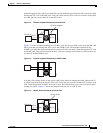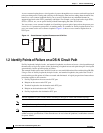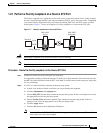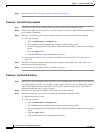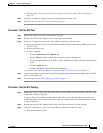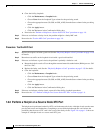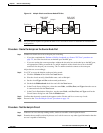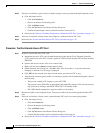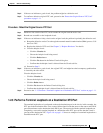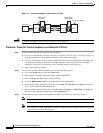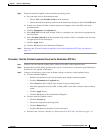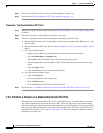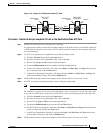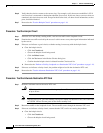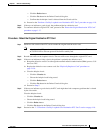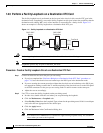
1-11
Cisco ONS 15327 Troubleshooting Guide, R3.4
April 2003
Chapter 1 General Troubleshooting
Identify Points of Failure on a DS-N Circuit Path
Step 4 If the test set indicates a good circuit, the problem might be a defective card.
Step 5 To confirm a defective original XTC card, proceed to the “Retest the Original Source XTC Card”
procedure on page 1-11.
Procedure: Retest the Original Source XTC Card
Step 1 Perform a side switch of the XTC cards to make the original card the active card.
Step 2 Resend test-set traffic on the loopback circuit.
Step 3 If the test set indicates a faulty circuit on the original card, the problem is probably the defective card:
a. Return the defective card to Cisco through the returned materials authorization (RMA) process. Call
the Cisco TAC.
b. Replace the defective XTC card. See Chapter 3, “Replace Hardware” for details.
c. Clear the hairpin circuit:
• Click the Circuits tab.
• Choose the hairpin circuit being tested.
• Click the Delete button.
• Click the Yes button in the Delete Circuits dialog box.
• Confirm that the hairpin circuit is deleted from the Circuits tab list.
d. Proceed to Step 5.
Step 4 If the test set indicates a good circuit, the original XTC card might have had a temporary problem that
is cleared by the side switch.
Clear the hairpin circuit:
• Click the Circuits tab.
• Choose the hairpin circuit being tested.
• Click the Delete button.
• Click the Yes button in the Delete Circuits dialog box.
• Confirm that the hairpin circuit is deleted from the Circuits tab list.
Step 5 Proceed to the “1.2.3 Perform a Terminal Loopback on a Destination XTC Port” section on page 1-11.
1.2.3 Perform a Terminal Loopback on a Destination XTC Port
The terminal loopback test is performed on the node destination port in the circuit; in this example, the
XTC port in the destination node. First, create a bidirectional circuit that starts on the source node DS-N
port and terminates on the destination node DS-N port. Then proceed with the terminal loopback test.
Completing a successful terminal loopback to a destination node XTC port verifies that the circuit is
good up to the destination XTC. Figure 1-9 on page 1-12 shows an example of a terminal loopback on a
destination node XTC port.



